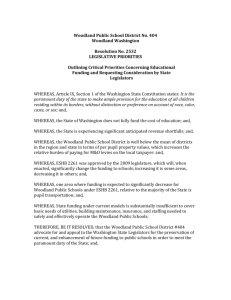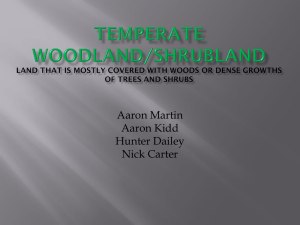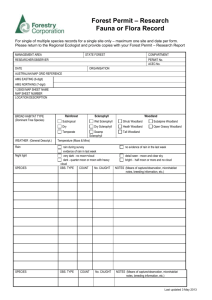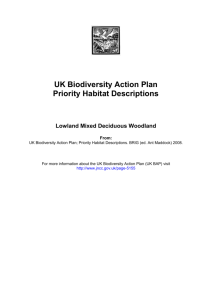Woodland (79-63)
advertisement
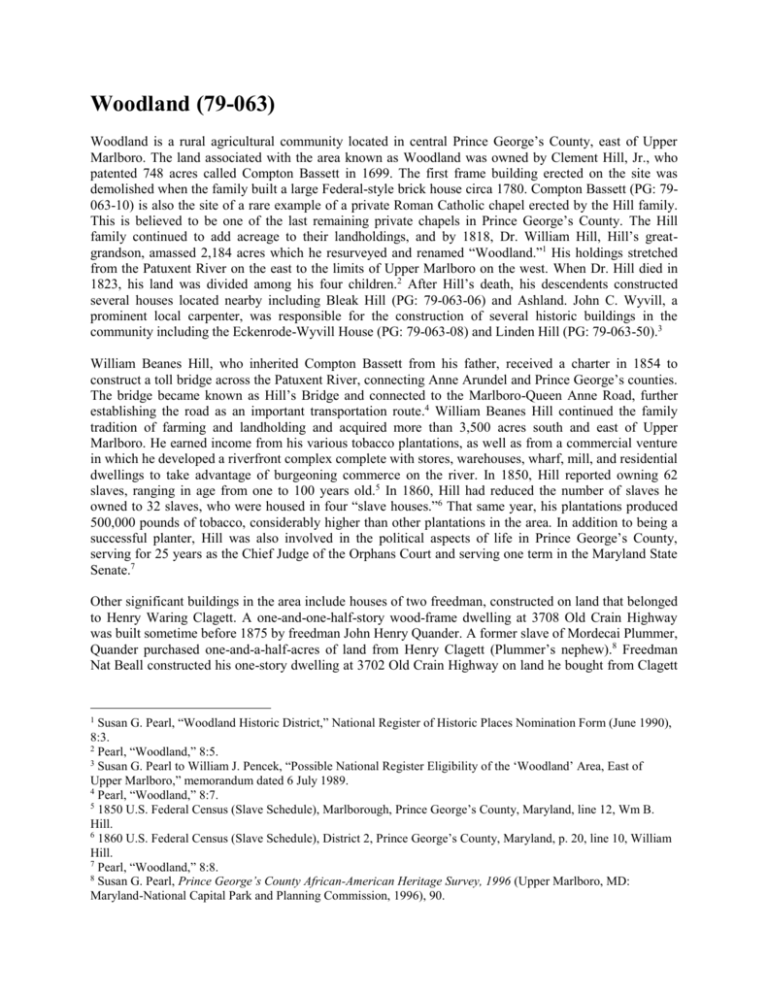
Woodland (79-063) Woodland is a rural agricultural community located in central Prince George’s County, east of Upper Marlboro. The land associated with the area known as Woodland was owned by Clement Hill, Jr., who patented 748 acres called Compton Bassett in 1699. The first frame building erected on the site was demolished when the family built a large Federal-style brick house circa 1780. Compton Bassett (PG: 79063-10) is also the site of a rare example of a private Roman Catholic chapel erected by the Hill family. This is believed to be one of the last remaining private chapels in Prince George’s County. The Hill family continued to add acreage to their landholdings, and by 1818, Dr. William Hill, Hill’s greatgrandson, amassed 2,184 acres which he resurveyed and renamed “Woodland.”1 His holdings stretched from the Patuxent River on the east to the limits of Upper Marlboro on the west. When Dr. Hill died in 1823, his land was divided among his four children.2 After Hill’s death, his descendents constructed several houses located nearby including Bleak Hill (PG: 79-063-06) and Ashland. John C. Wyvill, a prominent local carpenter, was responsible for the construction of several historic buildings in the community including the Eckenrode-Wyvill House (PG: 79-063-08) and Linden Hill (PG: 79-063-50).3 William Beanes Hill, who inherited Compton Bassett from his father, received a charter in 1854 to construct a toll bridge across the Patuxent River, connecting Anne Arundel and Prince George’s counties. The bridge became known as Hill’s Bridge and connected to the Marlboro-Queen Anne Road, further establishing the road as an important transportation route.4 William Beanes Hill continued the family tradition of farming and landholding and acquired more than 3,500 acres south and east of Upper Marlboro. He earned income from his various tobacco plantations, as well as from a commercial venture in which he developed a riverfront complex complete with stores, warehouses, wharf, mill, and residential dwellings to take advantage of burgeoning commerce on the river. In 1850, Hill reported owning 62 slaves, ranging in age from one to 100 years old.5 In 1860, Hill had reduced the number of slaves he owned to 32 slaves, who were housed in four “slave houses.”6 That same year, his plantations produced 500,000 pounds of tobacco, considerably higher than other plantations in the area. In addition to being a successful planter, Hill was also involved in the political aspects of life in Prince George’s County, serving for 25 years as the Chief Judge of the Orphans Court and serving one term in the Maryland State Senate.7 Other significant buildings in the area include houses of two freedman, constructed on land that belonged to Henry Waring Clagett. A one-and-one-half-story wood-frame dwelling at 3708 Old Crain Highway was built sometime before 1875 by freedman John Henry Quander. A former slave of Mordecai Plummer, Quander purchased one-and-a-half-acres of land from Henry Clagett (Plummer’s nephew).8 Freedman Nat Beall constructed his one-story dwelling at 3702 Old Crain Highway on land he bought from Clagett Susan G. Pearl, “Woodland Historic District,” National Register of Historic Places Nomination Form (June 1990), 8:3. 2 Pearl, “Woodland,” 8:5. 3 Susan G. Pearl to William J. Pencek, “Possible National Register Eligibility of the ‘Woodland’ Area, East of Upper Marlboro,” memorandum dated 6 July 1989. 4 Pearl, “Woodland,” 8:7. 5 1850 U.S. Federal Census (Slave Schedule), Marlborough, Prince George’s County, Maryland, line 12, Wm B. Hill. 6 1860 U.S. Federal Census (Slave Schedule), District 2, Prince George’s County, Maryland, p. 20, line 10, William Hill. 7 Pearl, “Woodland,” 8:8. 8 Susan G. Pearl, Prince George’s County African-American Heritage Survey, 1996 (Upper Marlboro, MD: Maryland-National Capital Park and Planning Commission, 1996), 90. 1 Woodland (79-063) 2 in 1874.9 The 1860 Federal Census lists Clagett as owning 26 slaves, thus, it may be possible that Beall was a former Clagett slave.10 Transportation is a significant theme in the Woodland community. Old Crain Highway, which bisects the community, is an important early road that roughly follows the circa 1700 Marlborough-Queen Anne Road, connecting the two port towns. When Upper Marlboro was designated as the new county seat in 1721, the Marlborough-Queen Anne Road began to see more traffic.11 Hill’s Bridge was constructed in 1854 over the Patuxent River, providing a connection between Anne Arundel and Prince George’s County. The construction of Robert Crain Highway in 1927 brought additional traffic through the agricultural community. This highway resulted in the closure of a portion of the original right-of-way, located near Bleak Hill.12 The construction of the Marlboro Bypass in the 1950s, which was later expanded and became U.S. Route 301, moved traffic to the east, effectively removing the majority of traffic through the community. This highway has allowed Woodland to remain a rural agricultural landscape. The 1861 Martenet map shows a rural landscape in the Woodland area. The only identifiable houses include that of Clement Hill and his son William Beanes Hill. Also shown is Hill’s Bridge across the Patuxent. By 1878, the Hopkins map documents more growth in the area. The Hill family has expanded and constructed additional buildings, and their waterfront complex on the river is also shown. Many other families are represented, including the Clagetts, Quander, and Beall families. The map also shows significant growth along what is now Marlboro Pike, leading into Upper Marlboro, the county seat.13 There are six designated Historic Sites in Woodland: PG: 79-063-05, Bowling Heights (NR), 3610 Old Crain Highway PG: 79-063-06, Bleak Hill, 4103 Old Crain Highway PG: 79-063-08, Eckenrode-Wyvill House, 4501 Wyvill Road PG: 79-063-10, Compton Bassett (NR), 16508 Marlboro Pike PG: 79-063-11, Ashland (NR), 16107 Marlboro Pike, 1867 PG: 79-063-50, Wyvill House (Linden Hill), 4102 Old Crain Highway There is one Historic Resource: PG: 79-063-07, Site of Bowling-Buck House, 4106 Old Crain Highway Windshield Survey Woodland remains a rural agricultural landscape, but new developments are beginning to encroach upon the community. A subdivision with late-twentieth-century residences is located outside of the survey area, northeast of the community. Winchester Homes is currently developing a large planned community called Pearl, “Woodland,” 8:8. 1860 U.S. Federal Census (Slave Schedule), District 2, Prince George’s County, Maryland, p. 60, line 17, Henry Clagett. 11 Pearl, “Woodland,” 8:6. 12 Susan G. Pearl to William J. Pencek, “Possible National Register Eligibility of the ‘Woodland’ Area, East of Upper Marlboro,” memorandum dated 6 July 1989. 13 Simon J. Martenet, “Atlas of Prince George’s County, Maryland, 1861, Adapted from Martenet’s Map of Prince George’s County, Maryland” (Baltimore: Simon J. Martenet C.E., 1861); G.M. Hopkins, “Atlas of Fifteen Miles Around Washington, Including the County of Prince George Maryland” (Philadelphia: G.M. Hopkins, C.E., 1878). 9 10 Woodland (79-063) 3 Stratford Estates in the center of the Woodland area. The new subdivision will feature 20 large singlefamily houses on lots between two and seven acres. Although a large development, conservation, forest conservation, afforestation, and scenic easements will protect neighboring properties from dramatic affect. The marshland owned by M-NCPPC located in the southeastern part of the community is protected from future development. The area’s rolling farmland contains large forested areas as well as land cleared for farming. The nearby Patuxent River provides a water supply for the land. There is very little modern infill within the Woodland community. Several bungalows, ranch houses, and modern Cape Cods appear in the community and range in date from the 1920s to the 1970s. The majority of buildings in the community date from the mid- to late nineteenth century and include excellent vernacular and high-style examples of Greek Revival, Italianate, Victorian Gothic, and Queen Anne styles. Numerous agricultural buildings dot the landscape. There are two commercial buildings located in the Woodland community. The intersection of Old Crain Highway and Marlboro Pike is now referred to as Well’s Corner. One building, a former bungalow, has been rehabilitated for use as a liquor store. The second commercial building was constructed in the 1950s and is currently being used as a bar/restaurant. Historic District Evaluation In 2001, the Maryland Historical Trust (MHT) determined that Woodland is eligible as a historic district under Criteria A for its association with the Hill family and Criteria C for the architectural merit of houses within the region.14 In June 1990, a National Register nomination form was prepared for the Woodland Historic District, but it was not submitted. The potential district contained 88 contributing resources and 41 non-contributing resources. Its period of significance was defined as 1780 – 1940. The 1,325-acre district is centered around Old Crain Highway and Marlboro Pike, with the Bowling Heights on the northern boundary, and Hill’s Bridge on the south. U.S. Route 301 serves as the western boundary, while the Patuxent River serves as the eastern boundary.15 Woodland represents several Prince George’s County Historic Themes including early plantation establishments, agricultural heritage, transportation, and residential architectural styles. The Woodland survey district meets the following Prince George’s County criteria for designation as a historic district: (1)(A)(i) – Woodland is an excellent example of an intact, contiguous rural agricultural community. It exemplifies the evolution of the agricultural community in Prince George’s County from the eighteenth century to the present. Because of the late settlement of Woodland and the agricultural use of the land over time, the community also has the potential to yield significant information about Native American inhabitants. Likewise, because of the historical use of the land for farming tobacco, the community may yield significant information about the enslaved African-American community in Prince George’s County. (1)(A)(iii) – Woodland is associated with the Hill family, who played a prominent role in the history of Prince George’s County and in Maryland. (1)(A)(iv) – Woodland is significant as a farming community that supported several successful tobacco plantations and was the home of a large enslaved population that helped to ensure that success. “Woodland Historic District,” Maryland Historical Trust NR Eligibility Review Form (July 2001). Susan G. Pearl, “Woodland Historic District,” National Register of Historic Places Nomination Form (June 1990), 7:1. 14 15 Woodland (79-063) 4 (2)(A)(i) – Woodland contains a variety of architecture that reflects distinct periods of time from the late eighteenth century to the first quarter of the twentieth century. Styles represented include excellent examples of Georgian/Federal, Greek Revival, Italianate, Victorian Gothic, Queen Anne, and Craftsman styles, which includes both vernacular and high-style designs. Woodland is also the site of a rare example of a private Roman Catholic chapel erected by the Hill family at Compton Bassett. This is believed to be one of the last remaining private chapels in Prince George’s County. (2)(A)(ii) – John C. Wyvill, a prominent local carpenter, was responsible for the construction of several historic buildings in the community, including the Eckenrode-Wyvill House and Linden Hill. Woodland is also eligible as a historic district in the National Register of Historic Places. The community meets the following criteria: Criterion A – Woodland is a fine example of an intact, rural agricultural community that reflects the continuity of change over time. Woodland is also representative of the importance of tobacco as a cash crop and the use of plantation slavery in Maryland’s agricultural history. It is also associated with the theme of transportation as it is the site of several important roads and bridges in Prince George’s County. Woodland contains two houses associated with freed AfricanAmericans, which illustrates the transition from slavery to freedom after the Civil War. Criterion C – Woodland contains a variety of architecture that reflects distinct periods of time from the late-eighteenth century to the first-quarter of the twentieth century. Styles represented include excellent examples of Georgian/Federal Greek Revival, Italianate, Victorian Gothic, Queen Anne, and Craftsman styles, which includes both vernacular and high-style designs. Woodland is also the site of a rare example of a private Roman Catholic chapel erected by the Hill family at Compton Bassett. This is believed to be one of the last remaining private chapels in Prince George’s County. Criterion D – The community has the potential to yield significant information about Native American inhabitants and the enslaved African-American community in Prince George’s County. In addition to its historic significance, Woodland has retained its integrity of location, design, setting, workmanship, materials, feeling, and association. Prepared by EHT Traceries, Inc. November 2007 Woodland (79-063) Woodland, 2005 Aerial = 2007 recommended historic district boundary 5 Woodland (79-063) Woodland, Martenet, 1861 = 2007 recommended historic district boundary 6 Woodland (79-063) Woodland, Hopkins, 1878 = 2007 recommended historic district boundary 7 Woodland (79-063) Woodland, 1938 Aerial = 2007 recommended historic district boundary 8 Woodland (79-063) Looking southeast, 3804 Old Crain Highway (EHT Traceries, 2007) 9 Woodland (79-063) 10 Looking southeast, Wyvill House/Linden Hill (PG: 79-063-50), 4102 Old Crain Highway (EHT Traceries, 2007) Woodland (79-063) Looking west towards Bleak Hill (PG: 79-063-06), 4103 Old Crain Highway, site of Stratford Estates by Winchester Homes (EHT Traceries, 2007) 11 Woodland (79-063) Looking north, Eckenrode-Wyvill House (PG: 79-063-08), 4501 Wyvill Road (EHT Traceries, 2007) 12 Woodland (79-063) Looking northwest, 16011-16007 Marlboro Pike (EHT Traceries, 2007) 13 Woodland (79-063) Looking northwest, 16007-16005 Marlboro Pike (EHT Traceries, 2007) 14 Woodland (79-063) Looking west, barn at 16301 Marlboro Pike (EHT Traceries, 2007) 15 Woodland (79-063) Looking south, 16001 Marlboro Pike, Wells Corner (EHT Traceries, 2007) 16 Woodland (79-063) Looking southwest, 15903 Marlboro Pike (EHT Traceries, 2007) 17




